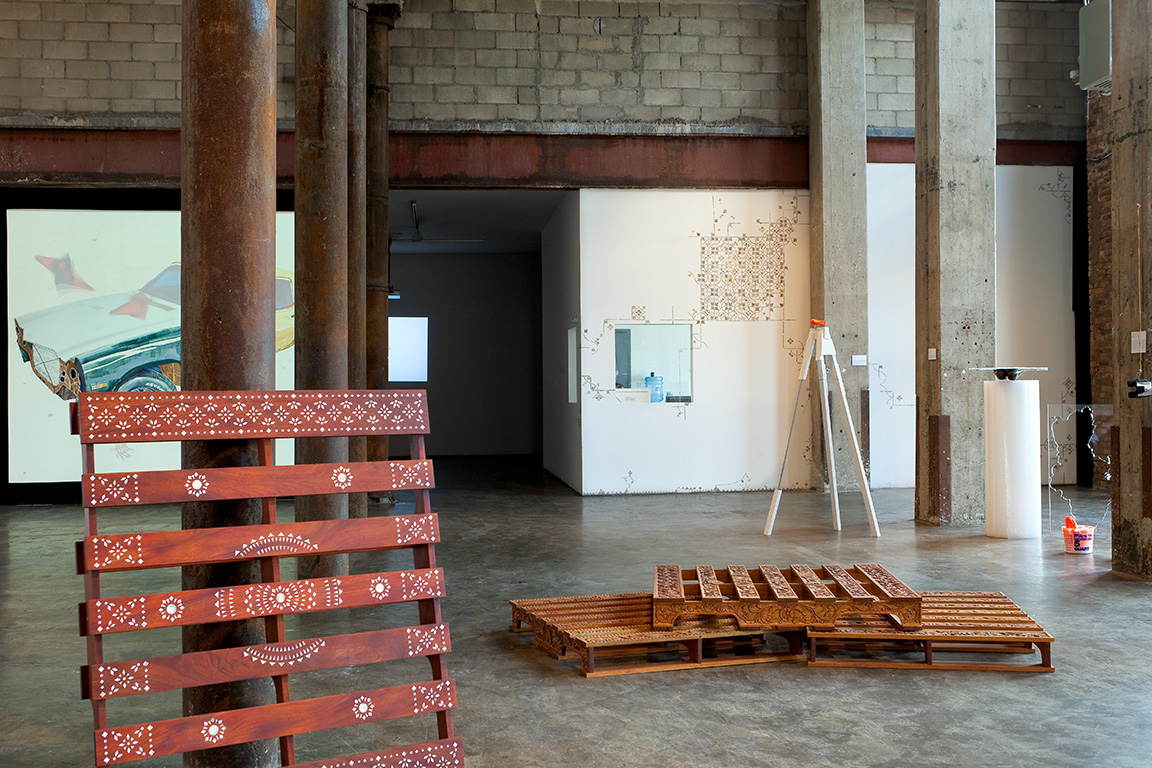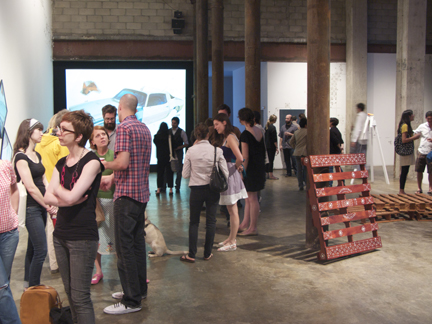Adriana Farmiga, Petrova Giberson, Isola and Norzi, Fawad Khan, Gareth Long, Alison Owen, Mike Quinn, Yumi Janairo Roth, Jen Schwarting, Secret School and the K.I.D.S., Charwei Tsai
Sunday, July 26 at 3pm: Artists Talk with Fawad Khan, Gareth Long, Alison Owen, Mike Quinn and a member of the Secret School and the K.I.D.S., moderated by curator Jeanne Gerrity.
Apropos of Robert Rauschenberg, John Cage once remarked, “Beauty is now underfoot wherever we take the trouble to look.” His comment suggests not merely that the commonplace can be transformed into art, but that this art has the potential for beauty. The artists in this exhibition take the banalities of life and transform them into poetic statements. The source material for these striking works, ranging from the dust on the floor of the gallery to text from a local newspapers, are rendered virtually unrecognizable by the artists’ aesthetic commitment.
The artists in Beauty Underfoot synthesize every moment of our daily experience, creating a sense of the sublime that paradoxically hovers between an extreme connection and a highly removed detachment from its derivation. Each work exists as a testament to their ability to mutate the quotidian into the lyrical. However, Beauty Underfoot goes even further, challenging the viewers to move beyond the aesthetic object, reviewing and confronting its source. When examined more closely, the works refer to mundaneness, hardship, and even injustice without any didacticism. The artists do not shy away from reality, but nor do they allow it to eclipse their creativity. The works in the exhibition ultimately transcend the ordinary, transforming it into the extraordinary.
Indebted to the tradition of assemblage, Adriana Farmiga’s work in Beauty Underfoot uses oft discarded items such as old shoes and empty buckets to create striking ostensibly abstracted sculptures, which actually stem from a more personal source. The daughter of Soviet dissident immigrants, Farmiga grew up in a Ukrainian community in the United States, bestowing her with a unique perspective on communist society and its scarcities in contrast to American consumerism and abundance. The found objects and added details in Farmiga’s three sculptures are signifiers of the artist’s own heritage. For example, the bright paint represents the Orange Revolution in the Ukraine, the shoes face west in reference to her parents’ immigration to the U.S., and the plexiglass is cut in the shape of her family’s native country.
Fawad Khan’s work often depicts aestheticized explosions inspired by media images of war interspersed with his own memories of vintage foreign-model automobiles from a childhood spent in Libya and Pakistan. Hood diverges from these politically nuanced representations, instead focusing on the animation of everyday objects that seem to come to life around an abandoned car in a junkyard. Life-size traffic cones, nuts and bolts, and plastic mesh created in Flash ricochet off the bouncing hood of the derelict car painted directly onto the wall of the gallery. Hood is also Khan’s first foray into integrating digital media and wall painting.
Vodka, pills, anti-depressants, cigarettes, and Diet Coke are among the materials that Mike Quinn uses to create his collages laid out according to mathematical graphs measuring failure and success. Quinn’s work references the role of alcohol and drugs in lending a false sense of happiness to the user, and, further exploring the nuances of wins and losses, he often utilizes sports as a metaphor for extremes in society.
While participating in a residency in the Philippines, Yumi Janairo Roth constructed shipping pallets using techniques associated with local handicrafts. She carved intricate designs in the pallets, and then reintroduced them into circulation. Upon her return to the United States, Roth continued to build shipping pallets from scratch, and in Paleta:Pallet (Made in the U.S.A.), she adorns the seemingly purely functional piece with a mother-of-pearl inlay. Roth’s pallets draw attention to otherwise overlooked objects, which transport goods around the world without retaining a sense of origin.
Alison Owen’s installations subtly highlight the peripheral elements of domestic space. Her wallpaper is composed of dirt and dust collected from the floor of Smack Mellon in the months preceding the exhibition, attached to double-sided adhesive cut into traditional patterns. Her wallpaper references ideas of women’s work and the detritus of everyday life, while her labor intensive process points to the unrecognized work of housewives and cleaning people around the country.
Petrova Giberson’s Waiting for the Tidal Wave that Will or Will Not Come combines two disparate videos into a coherent whole, juxtaposing a series of words culled from New Hampshire newspapers with footage of wind and light movements shot with an old camera from a New Hampshire window. Both videos draw attention to a certain beauty that exists within the everyday. The text-based video finds the poetic within the mundane headlines of local news stories, while the other video suggests meditations on outside space through the straightforward filming of one person’s view. The accompanying sculpture, Two Fall Days in January, is a cast-glass newspaper that belies the ephemerality of a daily newspaper, while nevertheless suggesting a certain fragility to the changing stories.
Bouvard and Pécuchet’s Invented Desk for Copying, a series of sculptures designed by Gareth Long, derives from Flaubert’s unfinished final novel, which challenges the concept of total knowledge and questions the authority of books as a legitimate site of learning. The novel is a satirical work that tells the tale of two copy-clerks who retire to the countryside to explore intellectual pursuits guided by didactic texts, but, failing miserably, ultimately decide to return to the banal task of copying other people’s ideas and experiences. In the last pages of the novel, the friends devise a plan to build a two-seated desk at which to copy again. Long has constructed a minimalist monument to the two clerks, using simple materials and symmetry to lend an elegance to their otherwise tedious pursuit.
Staring at the Sea is one manifestation of Isola and Norzi’s current research into the conceptual relationship between everyday objects and the underwater world as a mental escape space. A lifeguard chair, positioned toward the East River outside Smack Mellon’s window, is intersected with an aquarium full of living sea urchins. Staring at the Seamerges two different attempts to domesticate nature—the aquarium and the beach—in a paradoxical lyrical statement.
Secret School and the K.I.D.S. represents two loose artistic collaboratives, a group that explores the hidden and invisible in the social identity of a community, and “The Kindness and Imagination Development Society,” which seeks to bring out the good intentions and creativity inherent in children in the daily life of adults. For Beauty Underfoot, Secret School and the K.I.D.S. has created a green map reminiscent of subway maps in plastic cases ubiquitous in stations around New York City. Bee Line Transit Map, however, designates green spaces and is raised high in the gallery so that birds may see it through the second story windows. Binoculars are provided below so that humans may share in the viewing of the map.
Projected on the floor, the video in Charwei Tsai’s Fish Project shows the artist writing the text from the One China Policy onto a living fish struggling out of water. The One China Policy addresses the country’s ideology of uniting its people as one nation, declaring that mainland China, Hong Kong, Macau and Taiwan are all part of that nation. Tsai intends the work not as an attack on China specifically, but more as a means of asking people to consider the unnecessary suffering and death caused by the ideology of nationalism. The combined elements of the installation—the diffusion of the video through sand on the floor, the view of the projection through a veil, and the light strokes of the calligraphy—show a common tactic of disguising harsh truths through seemingly innocuous filters.
Jen Schwarting’s Nylon Shoot is particularly relevant in today’s contemporary climate of economic collapse and the resulting dread. Created specifically for Smack Mellon, the work is part of a series of parachutes that both reference literal safety devices used in air combat to slow a person from freefall, as well as the term “parachute,” which has occurred frequently in articles and discussions describing the government’s attempt to slow corporate and economic collapse. Schwarting sewed the parachute herself, allowing inconsistencies to draw attention to the omnipresence of human error in daily life.
This exhibition is made possible with public funds from the New York City Department of Cultural Affairs and the New York State Council on the Arts, a state agency, and with generous support from The Andy Warhol Foundation for the Visual Arts, The Greenwall Foundation, Jerome Foundation, Eve Sussman and Smack Mellon’s Members. Smack Mellon also receives generous support from the National Endowment for the Arts, Brooklyn Borough President Marty Markowitz, City Council Member David Yassky and the New York City Council, Bloomberg, Brooklyn Arts Council JPMorgan Chase Regrant Program, Fifth Floor Foundation, Foundation for Contemporary Arts, Goldman, Sachs & Co., The Greenwich Collection Ltd., Agnes Gund and Daniel Shapiro, Independence Community Foundation, Jean and Louis Dreyfus Foundation, Inc., Judith and Donald Rechler Foundation Inc., Lily Auchincloss Foundation Inc., Milton and Sally Avery Arts Foundation Inc., The New York Community Trust, The Pinkerton Foundation, The Robert Lehman Foundation, Robert Sterling Clark Foundation, Inc., The Starry Night Fund of Tides Foundation, The Roy and Niuta Titus Foundation, Inc., and William Talbott Hillman Foundation.
Space for Smack Mellon’s programs is generously provided by the Walentas Family and Two Trees Management.

